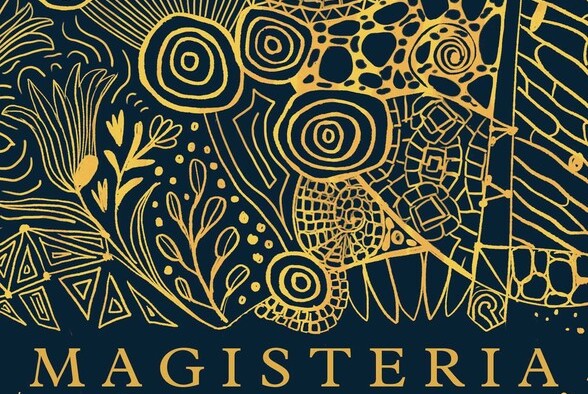
For over 150 years we have been told a story of conflict between science and religion. On closer inspection this narrative fragments, revealing far more nuance – and more interest – than we had been led to think. There is in fact no single history of science and religion, but a collection of entangled stories. The genuine flare-ups between these two magisteria tend to occur when people ask: 1) who are we, and 2) who has the authority to answer that question?
This was the message brought by Theos Senior Fellow Dr Nick Spencer in his lecture at the Cambridge Festival, hosted by The Faraday Institute earlier this week. This was one of the launch events for his recently published book, Magisteria: The Entangled Histories of Science and Religion(which, incidentally, has the most beautiful cover that I have seen for a long time[1]). I’ll summarise some of his lecture here, with a little extra help from his book.
The Belgian priest and cosmologist Georges Lemaître[2] was not yet important enough to be invited to the 5th Solvay conference. So he missed out on the latest discussions by scientific luminaries such as Albert Einstein, Marie Curie, Erwin Schrödinger[3] and Max Planck – in his own country. But he did get to meet Einstein. Someone had alerted the famous physicist to Lemaître’s paper which argued that the universe was expanding. They met for a walk in the park, but it might have been slightly fractious outing. While Einstein found Lemaître’s mathematics flawless, he thought his physics was ‘abominable’. It wasn’t just the priest’s expanding universe that was repellent to a genius who believed in the immutability of the universe, but the implication that it had a beginning. A number of physicists smelled a theological rat.
To be fair, Lemaître was deeply opposed to his science being used as an argument for the existence of a Creator. In an interview with the New York Times he said, ‘The writers of the Bible were illuminated…on the question of salvation. On other questions they were as wise or as ignorant as their generation.’ He even wrote to the Pope’s science advisor, requesting that His Holiness be asked not to make any more theological statements about the Big Bang.
Nick shared a number of other examples of scholars, from the sixth to the twentieth century, who reinforced this idea that the Bible does not teach science, and science cannot teach us theology. But if we see these as completely non-overlapping magisteria[4], do we lose too much?
Science and religion are different and distinct, but not completely separate disciplines. From the point of view of science, we have the ability to make the existence of God more or less credible. For example, scientists can say what kind of creatures humans are, and whether salvation can be a meaningful concept to us. What Nick has found in his research is that the real tension in the relationship between science and religion comes when one or the other makes statements about the nature of humankind that are proposed as authoritative and exclusive.
To give an example of genuine conflict between science and Christianity, the 1869 debate on Darwin’s views by Thomas Henry Huxley and Bishop Samuel Wilberforce was – for Huxley – primarily about authority. He would far rather have debated a professional scientist, and in front of a specialist audience (this can’t have won him any favours with the generalist audience that was present!) For Wilberforce[5], the question was not whether evolution could occur, but that surely humans could not have evolved – the idea was too degrading.
These two developments – the professionalisation of science and the evidence for our own evolution – are a large part of what triggered the ‘warfare narrative’ of science and religion. The story sparked by a real time-and-place conflict went on to spiral out of control, largely helped by a couple of irresponsible scholars who were more than happy to publish history books full of myths about science and Christian faith being eternallyin conflict.
What was actually going on was not a perpetual pitched battle, but a debate over description. Are we just our genes, or just dust? Are we human entirely because we have souls, or some kind of quintessence? Who has the authority to make such exclusive claims? The seventeenth century writer Margaret Cavendish is one of those who made no attempt to make what she saw as a false choice between spirit and matter. She believed that minds and ideas are material things, but that no creative mind can only be known through reason. In other words, we are both quintessence and dust, or quintessence of dust.
 Magisteria: The Entangled Histories of Science and Religion, by Nick Spencer, is available from Oneworld Publications (March 2023, hb, 480 pages, £25). Nick is Senior Fellow at the Theos think tank.
Magisteria: The Entangled Histories of Science and Religion, by Nick Spencer, is available from Oneworld Publications (March 2023, hb, 480 pages, £25). Nick is Senior Fellow at the Theos think tank.
Listen to Nick Spencer’s lecture here.
[1] It was designed by Emily Downe, who also produced this animation for Theos.
[2] Arguably now the most famous alumni of St Edmund’s College Cambridge, where The Faraday Institute has strong academic links.
[3] Originator of the famous cat analogy.
[4] To use phrase coined by the late atheist palaeontologist Stephen Jay Gould, from which Nick’s book gets its title.
[5] Who was not just a bishop, but happened to be a fellow of that exclusive scientific club, the Royal Society.




